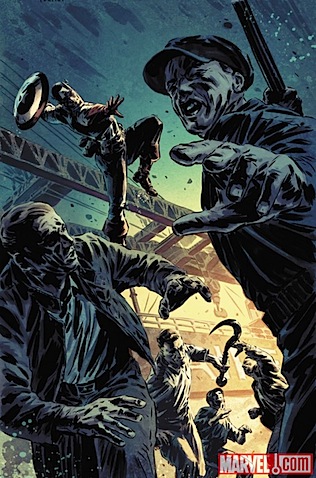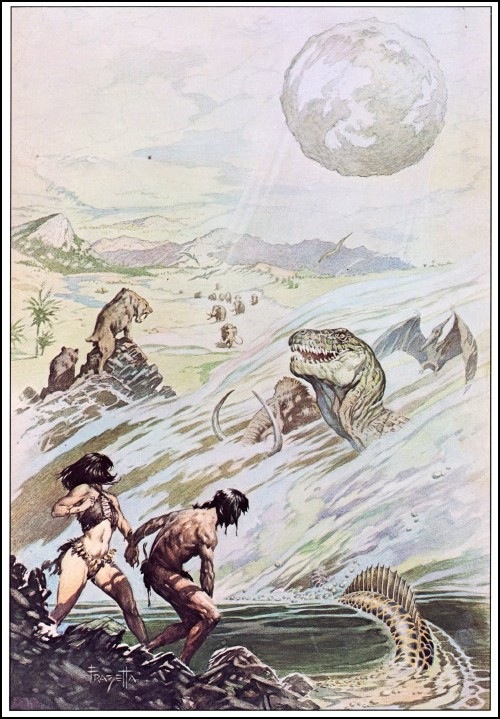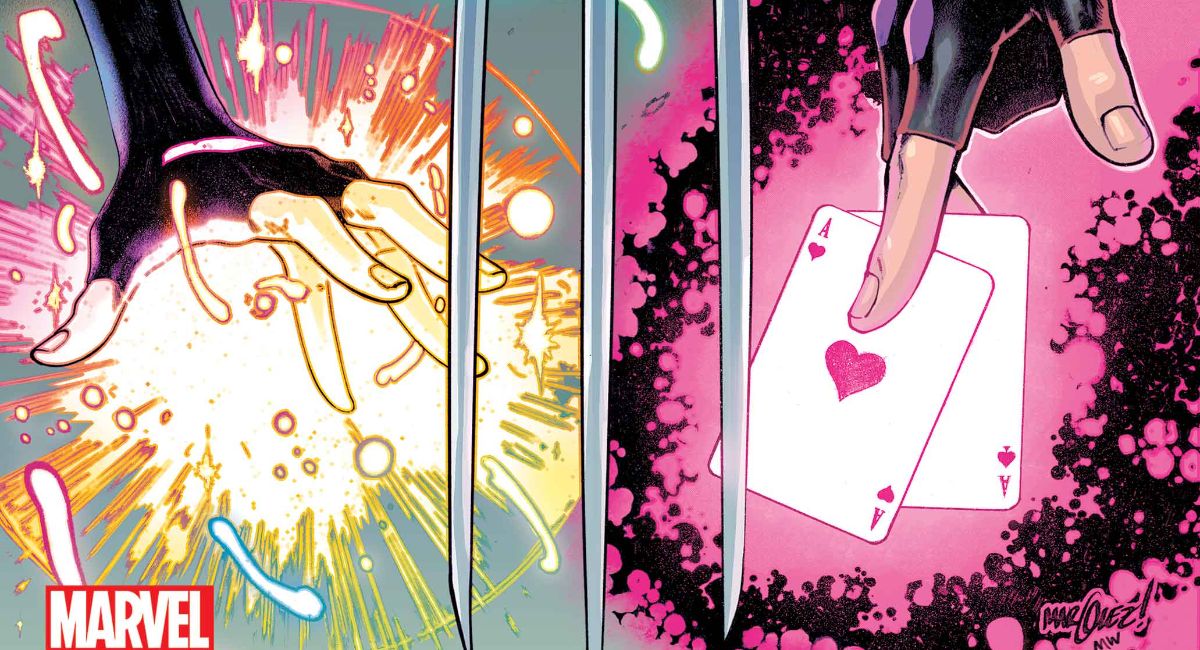• Frazetta department:
The accolades and appraisals continue to pour in for the irreplaceable Frank Frazetta. Spectrum’s Arnold Fenner pens a remembrance that’s more balanced than most.
He struggled. He had self-doubts. He had more than his share of disappointments in his life and every decision he made wasn’t the right one (and a few blew up in his face). By his own admission he was lazy and played more than he painted: contrast his body of work with that of his peers and his contention would seem to be true. Frazetta’s virtues were contrasted by his failings, his generosity sometimes blunted by his callousness. He masked his sensitivity with macho bravado, but when he hurt, the pain cut deep. As he said once, “When I’m down, Jesus, it’s hell.”
Viceland has a nice suite of appreciations from the punkier elements, including Johnny Ryan
Judging from the cover this had to be the most amazing album ever made. I imagined that this rock group Molly Hatchet must have recorded this album in a medieval dungeon, dressed in chainmail that was caked in dragon blood. I was expecting to hear songs about slaughtering goblins and dodging wizard lasers. I spent my meager allowance on this record and ran home. I couldn’t wait to hear it.Unfortunately, what I got when I finally played the record was a diaper-load of confederate ass rock.
…and Benjamin Marra
When I was in the 5th or 6th grade I was introduced to Frank Frazetta’s paintings through the Ballantine softcover-edition art books from the 70s. Looking at the reproductions of his paintings brought about a feeling of unidentifiable euphoria. It’s a feeling one only experiences as a youth, learning more about the world’s offerings. And it’s a feeling that exists only as a memory because as we age we experience it less and less.
§ Artist Jesse Hamm’s technical analysis of Frazetta’s genius sums up a lot of the things I was trying to get at the other day and shows how he pretty much owned Pyle and Wyeth for dynamics.
Frazetta would place the starkest light-against-dark contrast at the painting’s intended focal point (or, he’d closely surround that point with a handful of such contrasts). Then he’d lessen the contrast gradually throughout the rest of the painting, right out to the edges, where there was almost none at all. For balance and variety, he’d place a few spots of secondary contrast here and there, in orbit around the high-contrast focal point. And generally, he seemed to rely on a principle referred to by painter Greg Albert as “mostly, some, and a bit” — which is to say that the painting is made up of “mostly” one value (dark, medium, or light), “some” of a second value, and then a tiny “bit” of the third value, with unequal ratios between each amount and the others (e.g., 80/15/5 or 70/20/10, instead of 60/30/15), for maximum variety.
As Lance Laspina noted, had Frazetta lived in 16th century Italy, we’d be studying him today as one of the greatest biblical dramatists.
§ This post from Golden Age Comic Book Stories showing Frazetta’s covers for Edgar Rice Burroughs novels is pretty much ground zero for me; it’s my primal scene. I inherited my uncle’s collection of paperbacks swhen he went into the Army, and these didn’t just fire my youthful imagination–they set it ablaze with the white glow of a thousand bottle rockets exploding at once. Take this one — floods, dinosaurs, mammals, something huge slithering through the scene, a gibbous moon, the barbarian, the maiden…what a panoramic “Land of Terror” indeed. As so many have said, it didn’t matter what was between the covers wsith something like this on the front. I am not embarrassed to say that there are several covers in this post that I literally stared at for hours, trying to figure out what the hell was going on.
• Viz division
Kai-Ming Cha and Simon Jones weigh in on the Viz implosion. More to come.
• Neil Gaiman division
Gaiman responds to the ruckus over his library fee here, and as pointed out in the comments here and elsewhere, between putting his speaking fee high to discourage people and the amount of charity engagements he does — and heck, let’s throw in the fact that he’s one of the current era’s most beloved authors and a hell of a nice guy, too — and I think this case is closed.
• Kibbles ‘n’ Bits division:
§ G. Willow Wilson spoke recently about the different threads of her work — as comic book writer and as a Muslim essayist:
It’s very difficult to balance different audiences and talk to each one without selling the others short. There is no universal literature—or if there is, I don’t know how to write it. Comic book readers tend to be pretty secular and anti-authoritarian; nothing is above satire, in their eyes. Muslim readers tend to have a very narrow, precise idea about what constitutes acceptable art. Then there are readers of mainstream lit to whom both religion and comics are like foreign countries. My career is a black comedy of sorts. I spent a lot of time explaining myself to various different groups. But more and more I’m finding that the desire to communicate, which all these audiences share, is a powerful thing. I’ve gotten a humbling amount of support from people I never thought would reach out to me: conservative Muslims on the one hand, atheist artists on the other; people who would hate each other but don’t hate me. I try very hard to deserve that mutual confidence.
§ Joe Rybandt went to the Barcelona con and his liver barely escaped with its life.
§ On Twitter, the other day there was a big, raging discussion over whether colorists should get royalties, which David Pepose boiled down (how do you boil down 140 character discussions anyway?):
I know that writers, pencillers, and inkers do get royalties (and I do believe that colorists get royalties at Marvel as well), and I have heard that for some companies, editors get royalties as well. I do completely subscribe to the maxim that good colors can elevate (even bad) art, whereas nasty coloring can absolutely tank a book. And when it comes to deadlines, colorists and letterers get absolutely hammered, often pulling heroic hours without nearly enough thanks from the fan community.

§ Many DC trade paperbacks that you would not think are out of print….are out of print.
§ Marc-Oliver did a fine job of summing up the latest tell-all Joe Casey interview, but I imagine it will be a cold, cold day Buddha’s eight hot hells before Casey works at DC again…
This was a DC book that DC can’t do now because they moved too slow. When shit like this happens, they should be fuckin’ embarrassed. Now, that might all be changing with the new regime…I hope so, anyway…but we’ll have to see, won’t we? On the other hand, with my books at Image, I can have an idea one day, contact an artist the next day, and on the third day we’re rolling. We’re working. We’re creating. It’s the greatest buzz you can imagine. It’s why I wanted to do this for a living in the first place. Comics are supposed to be an immediate art form. Developing them by committee for years and years is just goddamn ridiculous. For Christ’s sake, the entire Marvel Universe was thought up on the fly by three or four guys in about two years, total…!
…and we’re guessin’ everyone’s just fine with that.










I appreciated Joe Casey’s mea culpa there, even if it was impolitic. DC’s branding of Casey’s Superman/Batman run as hearkening back to the Our Worlds at War event when the stories barely tied together (if at all) is the kind marketing that makes DC’s fan base cynical, and I’m glad someone said they were sorry, at least.
I actually love Casey’s honesty. Nothing wrong with a little transparency from time to time. This stuff comes out regardless. Whether or it’s now when the news is relevant or ten years from now in a “Comic Book Legends Revealed” column, people are going to find this stuff out anyway.
Why not be upfront about it?
“I actually love Casey’s honesty. Nothing wrong with a little transparency from time to time. This stuff comes out regardless. Whether or it’s now when the news is relevant or ten years from now in a “Comic Book Legends Revealed” column, people are going to find this stuff out anyway.
Why not be upfront about it?”
Nobody appreciates honesty anymore, especially when it’s not flattering honesty.
:(
That Frazetta painting you show at the head of this section can be seen if you visit Edgar Rice Burroughs, Inc. in Tarzana. It hangs on the wall of their office (which is a small cottage once used by ERB in the 1930s but is now on Ventura Blvd, the main street through town) along with seven or eight other 1960s Frazetta originals including The Mad King, Tarzan and The Lost Empire and Beyond The Farthest Star. ERB Inc acquired them from Ace Books back around 1965. They’re a decent size, around 12 x 16.